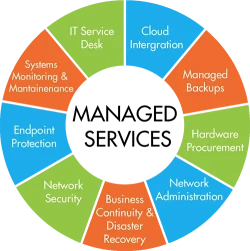In the digital age, every business faces an invisible battlefield where cybercriminals lurk, ready to exploit any vulnerabilities in your network. Welcome to the world of cybersecurity, a realm that demands vigilance, preparedness, and the implementation of robust protective measures. Among the most critical tools in your cybersecurity arsenal is the cybersecurity threat assessment. In this article, ‘Unveiling the Hidden Dangers: A Comprehensive Cybersecurity Threat Assessment’, we will explore this crucial process in detail.
A cybersecurity threat assessment is an essential aspect of risk management, helping small to medium-sized businesses like yours identify, evaluate, and mitigate potential cyber threats. This process can reveal the hidden dangers that may compromise your sensitive data, disrupt your operations, and negatively impact your bottom line. In an era where cyber attacks are becoming increasingly sophisticated and frequent, having a comprehensive cybersecurity threat assessment in place is no longer a luxury, but a necessity.
With the help of a cybersecurity-focused managed services provider like Upper Echelon Technology Group, you can tailor this process to your specific business needs and enjoy the benefits of an optimized and secure digital environment. Stay tuned as we delve deeper into the importance and intricacies of cybersecurity threat assessment, and how it can play an instrumental role in safeguarding your business.
Understanding Cybersecurity Threat Assessment
Imagine you’re playing a game of chess. To win, you need to anticipate your opponent’s moves, evaluate your position, and plan your strategy. In the world of cybersecurity, the game is much the same. Here, the chessboard is your business’s digital environment, and your opponent is the array of potential cyber threats lurking in the shadows. The key to winning? Conducting a comprehensive cybersecurity threat assessment.
Definition and Explanation of Cybersecurity Threat Assessment
A cybersecurity threat assessment, as defined by the National Institute of Standards and Technology (NIST), refers to a set of processes or tools that identify potential threats to your digital assets. These threats come in various forms and can disrupt your normal business operations or compromise the integrity of your assets. They can stem from direct attacks on your organization’s assets such as ransomware campaigns, human errors due to negligence or non-compliant practices, system failures of IT security controls, and even natural disasters outside of human control.
This process involves defining the threats that may affect your organization’s assets, identifying security vulnerabilities, determining the likelihood of threats, and evaluating the potential impact of these threats. The ultimate goal is to pinpoint and mitigate these threats before they can become full-blown attacks.
The Role of Cybersecurity Threat Assessment in Risk Management
Just as a chess player evaluates the board to minimize risks and plan for different scenarios, a cybersecurity threat assessment plays a vital role in risk management. It helps identify potential vulnerabilities in your system, providing you with a clear picture of where your defenses may be weak and where attacks are most likely to occur.
Threat assessments also help in prioritizing risks based on their likelihood and the potential impact on your business. By identifying the threats that pose the greatest risk to your organization, you can allocate resources more effectively, focusing on areas that need the most attention.
Furthermore, cybersecurity threat assessments can serve as a crucial component in developing a proactive cybersecurity strategy. They provide a basis for implementing protective measures, planning for potential attacks, and establishing a robust incident response plan.
In essence, understanding and conducting cybersecurity threat assessments is like having a strategic game plan in the complex world of cybersecurity. It allows you to stay one step ahead of potential threats, ensuring the integrity, availability, and confidentiality of your sensitive data. As a business owner, it’s not just about playing the game – it’s about winning it. And in the realm of cybersecurity, the stakes couldn’t be higher.
The Four Steps of the Cybersecurity Threat Assessment Process
Navigating the treacherous waters of cybersecurity threats requires a well-defined map. A systematic approach to identifying, analyzing, and addressing these threats forms the cornerstone of a robust cybersecurity strategy. Let’s dive into the five crucial steps of the cybersecurity threat assessment process.
Step 1: Notification of a Threat
The first step in a cybersecurity threat assessment is the notification of a potential threat. It involves being alerted to any suspicious activities or events that could pose a risk to your network and digital assets. This could come from various sources, such as internal monitoring tools, third-party vendors, or security advisories.
Step 2: Information Gathering
Upon receiving notification of a potential threat, the next course of action is information gathering. This step is all about collecting as much data as possible about the threat, its source, and its potential impact. It can involve monitoring network traffic, examining log files, and liaising with external cybersecurity agencies.
Step 3: Analysis of Information
After collecting all relevant information, it’s time to analyze it. This step involves making sense of the gathered data and understanding the nature of the threat. It requires a deep understanding of the threat landscape and the ability to differentiate between false alarms and actual threats.
Step 4: Assessing the Threat
The fourth step is assessing the threat. At this stage, potential impacts on key business objectives and essential IT assets are evaluated. This assessment provides a clear picture of the severity of the threat and assists in deciding on the appropriate response.
Step 5: Making the Assessment
The final step is making the assessment. This involves drawing conclusions from the analyzed data and deciding on the next steps. The result could range from implementing immediate defensive measures to mitigate the threat, to documenting the threat for future reference if it’s deemed a low risk.
The threat assessment process is a dynamic and ongoing cycle. Its primary goal is to provide a clear understanding of the cybersecurity risks faced by your business, enabling you to make informed decisions on how to protect your vital digital assets. As a business owner in Wilmington, DE, understanding these steps can be invaluable in making your business more resilient to cyber threats.
Key Elements of a Comprehensive Cybersecurity Threat Assessment
A comprehensive cybersecurity threat assessment isn’t a one-size-fits-all solution. It is a multi-faceted process that requires a keen understanding of your business objectives, the IT assets you possess, and the potential cyber attacks your business might face. Here are the key elements that make up a thorough cybersecurity threat assessment.
Identifying Key Business Objectives and Essential IT Assets
You can’t protect what you don’t know. The first step in a comprehensive cybersecurity threat assessment is to identify your key business objectives and the IT assets that support them. This includes not only your organization’s most valuable assets (often referred to as the “crown jewels”) but also those assets which attackers would want to gain control over, such as an Active Directory server or communication systems. These assets become the main target of attackers and can serve as pivot points to expand an attack.
Identifying Potential Cyber Attacks and Assessing Their Likelihood and Impact
Once you’ve identified your key IT assets, the next step is to identify the potential cyber threats your business could face. You should use a threat library like the MITRE ATT&CK Knowledge Base or resources from the Cyber Threat Alliance to help identify possible threats. You should also consider the intent and capability of potential cybercriminals, as well as the intended target, to assess the likelihood of a threat.
Analyzing and Prioritizing Risks Based on Their Likelihood and Impact
After identifying potential cyber attacks, it’s important to analyze and prioritize these risks based on their likelihood and impact. This involves evaluating factors like the intent of the adversary, the sophistication of the attack vector, and the potential target. You should also consider how easily an attack could be prevented, identified, and addressed if it were to occur.
Implementing Measures to Mitigate or Manage the Risks
Once you’ve identified and prioritized your risks, the next step is to implement measures to mitigate or manage these risks. This might involve improving your cybersecurity infrastructure, enhancing your risk management practices, or improving oversight of third-party cybersecurity compliance.
Documenting the Process in a Risk Register
Finally, it’s important to document the entire threat assessment process in a risk register. This can provide a valuable record of your cybersecurity risks, the measures you’ve taken to mitigate them, and any gaps that might still exist. It can also provide a roadmap for future cybersecurity threat assessments.
A comprehensive cybersecurity threat assessment is a critical tool in protecting your business from cyber threats. By identifying your key business objectives and IT assets, identifying potential cyber attacks, assessing their likelihood and impact, implementing measures to manage these risks, and documenting the process, you can ensure your business is well-protected against the ever-evolving landscape of cybersecurity threats.
The Role of Managed Services Providers in Cybersecurity Threat Assessment
In the ever-evolving landscape of cybersecurity threats, having a reliable partner that understands your unique business needs is invaluable. This is where managed services providers (MSPs) come into the picture. MSPs, such as Upper Echelon Technology Group LLC, play a pivotal role in conducting comprehensive cybersecurity threat assessments for your business.
How Upper Echelon Technology Group LLC Provides Personalized Cybersecurity Threat Assessment Services
At Upper Echelon Technology Group LLC, we don’t believe in one-size-fits-all solutions. Our approach to cybersecurity threat assessment is personalized, catering to the unique needs and goals of your business. We go beyond simply fixing tech issues, focusing instead on leveraging your technology assets in the best possible way to support your business.
Our experts start by understanding your business objectives and identifying your essential IT assets. We then assess potential cyber attacks, their likelihood, and potential impact on your business. We analyze and prioritize these risks based on their likelihood and impact, creating a strategic plan to mitigate or manage these risks effectively. Finally, we document the entire process in a risk register, providing you with a comprehensive overview of your business’s risk landscape.
The Benefits of Outsourcing Cybersecurity Threat Assessment to Managed Services Providers
Outsourcing your cybersecurity threat assessment to a managed services provider like Upper Echelon Technology Group LLC brings several benefits.
Efficiency and expertise: We have a team of cybersecurity professionals with years of experience in conducting threat assessments. Our expertise ensures an efficient and thorough assessment, saving you time and resources.
24x7x365 support: Our team is always on hand to address any security concerns that may arise, providing you with peace of mind knowing that your business is protected round-the-clock.
Risk management: By identifying and analyzing potential cybersecurity threats, we enable you to proactively manage risks and prevent potential security breaches.
Cost-effectiveness: Outsourcing eliminates the need for in-house security expertise, which can be expensive to maintain. We provide top-tier security services at a fraction of the cost, improving your bottom line.
Business growth: By taking care of your cybersecurity needs, we free up your time to focus on what you do best – growing your business.
In conclusion, incorporating cybersecurity threat assessment into your business strategy is key to safeguarding your IT infrastructure from potential threats. By partnering with a trusted managed services provider like Upper Echelon Technology Group LLC, you can ensure that your business remains secure, efficient, and profitable in the digital age.
Conclusion: The Critical Role of Cybersecurity Threat Assessment in Protecting Your Business
In the digital landscape of the 21st century, cybersecurity is not a luxury, but a necessity. As we’ve explored throughout this article, a comprehensive cybersecurity threat assessment aims to identify and mitigate potential threats to your business’s digital assets. The critical role of this process in safeguarding your IT infrastructure cannot be overstated.
A cybersecurity threat assessment is not a one-time event, but an ongoing process that should be integral to your organization’s proactive security strategy. It helps you to stay ahead of potential threats, understanding the likelihood of their occurrence, and the potential impact they could have on your business. By systematically identifying your organization’s vulnerabilities, you can take decisive action to close these security gaps before they are exploited.
Working with a cybersecurity-focused managed services provider such as Upper Echelon Technology Group LLC can make this process more efficient and effective. Our personalized approach to IT Managed Services ensures that your technology issues are resolved, your team becomes more efficient, and your company profits from the strategic use of technology. We understand that each business is unique, and we tailor our services to meet your specific needs and circumstances.
Ultimately, the goal of a comprehensive cybersecurity threat assessment is to protect your business from potential threats and ensure the integrity, availability, and confidentiality of your digital assets. With the increasing sophistication of cyber threats, this process is more critical than ever. It’s not just about protecting your data – it’s about safeguarding your business’s reputation, ensuring the trust of your customers, and securing your business’s future in an increasingly digital world.
By arming yourself with the knowledge of potential threats and vulnerabilities, and by partnering with a trusted managed services provider like Upper Echelon Technology Group LLC, you’re taking a proactive stance against the cyber threats of today and tomorrow. In the world of cybersecurity, knowledge is indeed power. And that power can be the difference between a business that survives and thrives in the digital age, and one that falls victim to the hidden dangers of cyberspace.
Remember, a robust cybersecurity posture is not just a protective shield; it’s a competitive advantage that sets your business apart. So take the first step today by conducting a comprehensive cybersecurity threat assessment, and secure the future of your business in the digital age.




